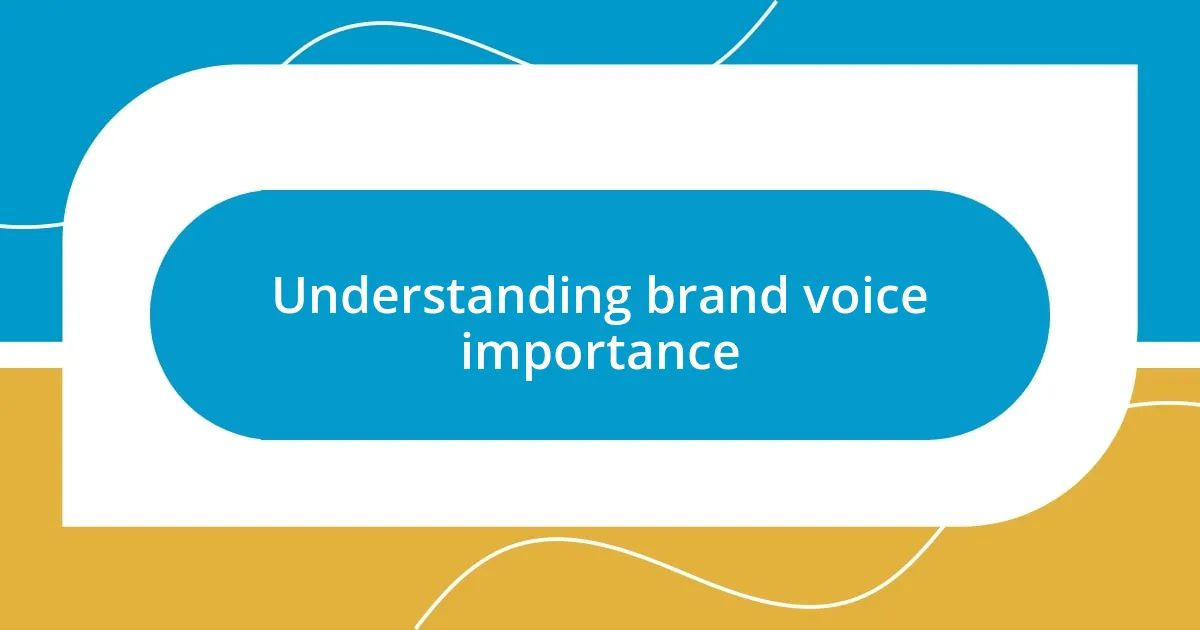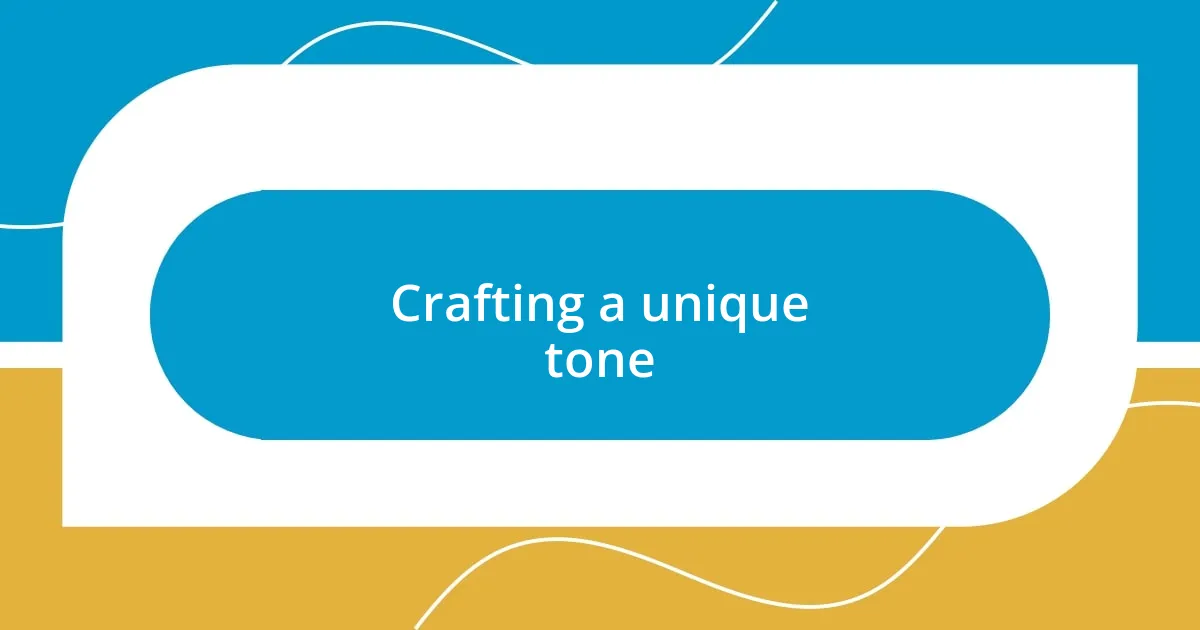Key takeaways:
- Brand voice fosters deep connections with the audience and reflects the personality and values of the business.
- Identifying target audience insights is crucial for crafting relatable messaging, using methods like surveys and social media analysis.
- Defining core brand values provides stability and clarity, guiding messaging and actions for authenticity and cohesion.
- Consistent implementation of brand voice across different platforms is essential for maintaining integrity while adapting to context.

Understanding brand voice importance
When I first started developing my brand voice, I quickly realized that it wasn’t just about the words I chose, but how those words made my audience feel. I remember a time when I received feedback from a customer who felt genuinely connected to my brand because of the warm, inviting tone I used in my messaging. Isn’t that amazing? A simple choice in tone can foster such deep connections.
Understanding the importance of brand voice is crucial; it sets the stage for trust and recognition. Think about your favorite brands—what do they all have in common? Their voice is consistent, whether it’s playful or serious, making it easier for you to relate to them. I’ve found that aligning my brand voice with my values not only attracts the right audience but also cultivates loyalty, something I deeply value.
To me, brand voice acts like the personality of your business. It speaks volumes about who you are and what you stand for. The moment I embraced this concept, it became clear that my brand voice should reflect my passions, my mission, and the unique journey I wanted to share. Can you imagine how empowering it is to let your true self shine through your words? That’s when I realized, my brand voice wasn’t just a tool—it was the essence of my brand.

Identifying target audience insights
Identifying your target audience is like tuning in to a favorite radio station; when you get it right, everything resonates perfectly. I’ll never forget the moment I realized that my audience is not just a number or a statistic, but real people with unique desires and pain points. Understanding their lifestyle preferences allowed me to craft messages that speak directly to them, making my brand feel approachable and relatable.
As I delved deeper into audience insights, I found that social media engagement provides a goldmine of information. For instance, I discovered that a segment of my followers responded positively to storytelling elements in my posts—those little personal anecdotes about my journey. This feedback was invaluable, guiding me to weave more of my experiences into my messaging. Has anyone else noticed how a simple question can spark a genuine connection? It’s like opening a door to a heartfelt conversation.
The journey of identifying audience insights also taught me the power of empathy. It’s not just about selling a product but understanding their struggles and aspirations. I’ve often reached out for direct feedback, and those conversations have shaped not only my voice but also the products I offer. It’s fascinating how the more I listen, the better I can serve. When was the last time you asked your audience about their needs? That simple act can transform your approach completely.
| Insight Method | Description |
|---|---|
| Surveys | Direct feedback from your audience to understand their preferences. |
| Social Media Analysis | Monitoring engagement to uncover what resonates with your audience. |
| Interviews | Personal conversations allowing deeper insights into customer needs. |

Defining core brand values
Defining core brand values is like setting the foundation of a house; it provides stability and direction for everything that follows. I remember attending a workshop where we mapped out our brand values, and it struck me how much clarity this simple exercise brought to my business. It helped me understand exactly what I wanted my brand to stand for—integrity, innovation, and community. Once I pinpointed those values, I felt a renewed energy to share my message with others in an authentic way.
To make this process as meaningful as possible, I created a list that encapsulated my brand’s essence:
- Integrity: Always be honest and transparent with my audience.
- Innovation: Embrace new ideas and stay ahead of the curve.
- Community: Foster a sense of belonging among my customers and encourage their voices.
These core values became my guiding principles. They not only shaped my messaging but also influenced my decisions, making my brand more cohesive and relatable. When I align my actions with these values, it feels less like work and more like living out my passion every day. Have you ever had that moment when everything just clicks? That’s what defining your core brand values can do for you.

Crafting a unique tone
Crafting a unique tone is an intimate process that reflects your brand’s personality. I vividly recall the early days when I experimented with different styles, trying to find my voice. One day, after a particularly successful post that felt authentic to my experience, I realized that my tone could blend professionalism with warmth. This revelation was like breathing fresh air; it allowed me to connect more deeply with my audience. Have you ever felt that exhilarating moment of self-discovery?
As I continued developing my tone, I leaned into the quirks that made me, well, me! I started adding humor and a conversational flow, treating my audience as friends rather than just consumers. It was a pivotal change; when I shared a light-hearted story about a major blunder I made in my business, the response was overwhelming. People appreciated the transparency. Doesn’t it feel good when you let your guard down and people respond positively?
Finally, I discovered that consistency is key in crafting my tone. Once I established a specific voice, whether it be playful or serious, I made it a point to stick with it across all platforms. It wasn’t always easy, but persistence paid off. Now, when I post or interact, my audience knows what to expect—it’s like a signature that sets me apart. Have you found what your signature voice is yet? It’s worth the journey to discover it!

Developing consistent messaging strategies
Developing messaging strategies requires a thoughtful approach to ensure consistency. I remember creating a detailed messaging blueprint that helped me clarify what to say and how to say it. It felt like building a roadmap for my brand; each touchpoint became an opportunity to reinforce my values and tone. Doesn’t it feel comforting to have a guide that simplifies your journey?
To maintain that consistency, I made it a practice to review my messaging regularly. For instance, I set aside time each month to assess whether my communications reflected my core values. This habit not only kept me aligned but also allowed me to adapt to any changes in my brand’s direction. Have you ever found that your message might need a little tune-up?
I also found it helpful to create templates or guidelines that everyone involved with my brand could refer to. By sharing these resources with my team, I ensured that our messaging echoed a unified voice. It was rewarding to witness how teamwork transformed our communication. When everyone is on the same page, I think it truly elevates the brand experience. Have you ever collaborated with others on a shared vision? The magic of aligned messaging is something worth experiencing together.

Implementing brand voice across platforms
Implementing my brand voice across various platforms was a journey filled with experimentation and adaptation. Initially, I faced some challenges when I noticed that certain tones resonated differently depending on whether I was on Instagram, LinkedIn, or my blog. For instance, the playful tone that thrived on social media didn’t always translate as effectively in my more formal newsletter. Have you ever felt the pressure to adjust your voice to fit different contexts? It can be a balancing act, but it’s crucial for maintaining your brand’s integrity.
To make this easier, I began keeping a “voice checklist” for each platform, identifying specific keywords and phrases that felt right for each one. I remember crafting a light-hearted tweet that garnered lots of laughs, and I realized that mirroring that fun, conversational style in my Instagram captions made sense too. However, for professional platforms, I had to swap in more authoritative language while still embracing my core voice. This process was both enlightening and a bit daunting; it pushed me to dig deeper into what made my voice unique across different channels. Ever thought about how a slight shift in tone can change the audience’s perception completely?
As I implemented my brand voice, I also learned the significance of feedback. Engaging with my audience became a way to refine and adjust how I communicated. I vividly recall a moment after sharing a heartfelt story on my blog; the response was incredible! People reached out, sharing their similar experiences and connecting at a personal level. It taught me that my voice, when authentically consistent across platforms, not only resonated but fostered genuine relationships. Don’t you find it rewarding when your audience feels seen and heard? This journey is about cultivating those lasting connections through a voice that truly reflects who you are.

Evaluating and adapting brand voice
Evaluating my brand voice was a process of constant reflection and openness to change. I remember a particular instance where I received feedback from a loyal follower who expressed that my recent posts felt a bit off-brand. It was a wake-up call! This kind of input helped me realize that, regardless of how confident I felt, the perception of my voice mattered immensely. Have you ever had a moment where outside perspectives shifted your understanding of your brand?
I found it essential to revisit my messaging at least every few months. This regular assessment allowed me to identify shifts in audience expectations or market trends that warranted a voice recalibration. One time, I noticed an emerging trend in authenticity-driven communication; it encouraged me to strip down some of the formal jargon I had been using. Instead, I embraced a more relatable tone. Isn’t it fascinating how adapting your voice can redefine how your audience connects with you?
Listening to my audience didn’t just inform my adjustments; it inspired new content ideas. During one of my evaluations, I discovered common themes in the comments and messages I received, guiding me to refine my topics and approach. For instance, readers often conveyed a desire for more behind-the-scenes insights, prompting me to create a series that explored my daily processes. Engaging with your audience in this manner makes you feel more like a friend than a brand, wouldn’t you agree? It fosters a relationship rooted in authenticity, which is the ultimate goal of developing a brand voice that truly resonates.














